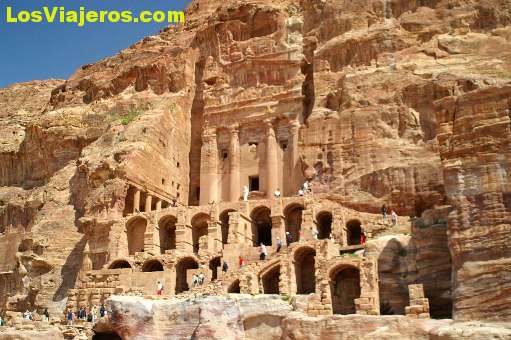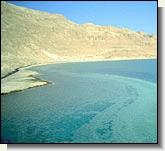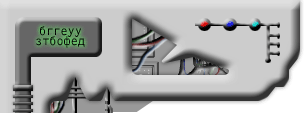|
AT DUSK, AFTER THE
TOURISTS HAVE LEFT,
JORDAN'S ANCIENT RUIN
COMES TO SPLENDID LIFE.
BY MAXINE
ROSE SCHUR | "Sudden around me rocks and cliffs arise; the earth their footstool, and their crown, the skies."
-- John William Burgon, "Petra" (1845)
Thirty centuries ago, a Bedouin tribe from Arabia arrived in
the land that is now Jordan. Here, they pitched their tents, tended their fires and gathered their flocks. The nomads came
merely to graze their animals -- but over time they did something extraordinary. They not only settled and tilled the land,
they built an empire that rivaled Rome.
These extraordinary people were the Nabateans, and their prosperity came
from the location of their capital, Petra, at the junction of trade routes linking Rome with China and India. By imposing
taxes on the spices and silks that passed through Petra, and by offering protection from marauding tribes, the Nabateans grew
fabulously rich. Their empire stretched from Syria to Egypt, and Petra was its crown jewel. A vast, elegant city, carved entirely
out of colorful stone, Petra became one of the most important cities of the ancient world.
But then, in the third
century, the Romans diverted the trade routes away from Petra, and the Nabatean civilization swiftly declined. By the fourth
century Nabatea disappeared. For the next 15 centuries, the location of Petra was lost to the world.
Then, one autumn
day in 1812, the fabled city was discovered hidden in a mountain cleft by an adventurous young Englishman.
Last
year I discovered it.
The best way to discover Petra is to first see it as I did: at the wrong time of day. Instead
of arriving in the tourist-traffic of morning, I came just before dusk. I came alone. I came on foot with neither guidebook
nor guide. I began my walk when the air hangs still and all about, the mountains ring with the pitiable voices of sheep.
I had come to the village of Wadi Musa with my husband and two sons in a taxi from Amman. It was late afternoon when
we arrived, and as we planned "to do Petra" the next day, the others chose to explore the cliff-edge village. But
I wanted a preview, no matter how brief, so I took the hotel van to the entrance of the ancient site and arranged a pick-up
time with the driver. And there, at the shabby ticket booth that marks the entrance to Petra, I unknowingly began a quest.
As I made my way down the broad dirt trail, departing horseback riders and carriages clattered past on my right.
The trail sliced through the wadi, which was carpeted with a winter stubble of dry grass, scraggly oleander and gorse. On
either side stood the ruins of outer Petra, notably hundreds of Nabatean tombs, a honeycomb of caves gouged into the craggy
red cliffs.
Where the trail narrowed, I came upon splintery wooden tables lined up on the right. Along with postcards,
here you could buy the ubiquitous Jordanian souvenir: a small bottle of pastel-colored sand with your own name written into
it by fine black powder poured through bent wire. At this time of day, only a few vendors remained. I stopped to watch a returning
tourist have his name poured into a bottle.
"See. See. See. See."

Petra Moon Tourism

The Dead Sea - Jordan's natural spa
The Dead Sea is world renowned for its medical attributes, healing numerous
skin disorders. For years, people from all over the world, especially cold-climate countries in Europe, have come to this
natural spa for the most natural treatment available.
This season, especially April and May, is the best time for
visiting the Dead Sea. According to a recent report appearing in the Malaysia-based New Sunday Times, the minerals in the
Dead Sea waters have had proven success in numerous cases of skin disease, especially with psoriasis cases.
Furthermore,
this relatively low-priced treatment is also a remedy for the soul. This time of year is especially suitable for such a visit,
with mild temperatures and warm breezes adding to the soothing experience.
Even for those not in need of medical
treatment, the Dead Sea is one of the most special experiences of visiting the Kingdom of Jordan, inviting for both young
and old.
|
 |
|
|
|
 |
|
Of the rich national legacy of the land and people of Jordan, perhaps the most ancient and enduring thread is our tradition
of making visitors from other countries our friends.
Of the rich national legacy of the land and people of Jordan, perhaps
the most ancient and enduring thread is our tradition of making visitors from other countries our friends.
For the
past 10,000 years, people from throughout the Middle East and the rest of the world have traveled the historic trade routes
which cross Jordan, marveling at the varied glory of God's nature, and ultimately leaving behind some joy, something learned
and some fresh hope for future generations.
Today, visitors come to Jordan to see its great natural beauty and
to see the Kingdom's historical and archaeological wealth. And as the centuries-old tradition of visiting Jordan continues,
our friendships with people and cultures from the four corners of the earth are renewed.
In Jordan, our welcome to
friends from other countries is as old as human travel itself. We welcome you to visit our country and to see its ancient
traditions and contemporary vitality.
The Hashemite Kingdom of Jordan evokes a simpler time, a sense of place and
a cherished way of life. A visit to Jordan brings a return to respected and hallowed tradition. Immediately upon arrival,
the visitor is aware of the inherent hospitality of the Jordanian people as exemplified by the Arabic "Ahlan wa sahlan"
('l welcome you'), heard at every turn.
Jordanians are very friendly, outgoing people,They are innately helpful and
enjoy having guests and visitors In their country and in their homes. Entertainment in Jordan revolves around family life
and neighborhood gatherings. Visitors are often fortunate enough to be brought into this ambiance, and are made to feel welcome
and are encouraged to enjoy themselves.
The visitor is made welcome wherever he goes, whether in the capital city,
Amman, or in one of the outlying towns and villages, or while visiting the historic sites and archaeological digs .
For the past 10,000 years, people from throughout the Middle East and the rest of the world have traveled the historic
trade routes which cross Jordan, marveling at the varied glory of God's nature, and ultimately leaving behind some joy, something
learned and some fresh hope for future generations.
Today, visitors come to Jordan to see its great natural
beauty and to see the Kingdom's historical and archaeological wealth. And as the centuries-old tradition of visiting Jordan
continues, our friendships with people and cultures from the four corners of the earth are renewed.
In Jordan, our
welcome to friends from other countries is as old as human travel itself. We welcome you to visit our country and to see its
ancient traditions and contemporary vitality.
The Hashemite Kingdom of Jordan evokes a simpler time, a sense of place
and a cherished way of life. A visit to Jordan brings a return to respected and hallowed tradition. Immediately upon arrival,
the visitor is aware of the inherent hospitality of the Jordanian people as exemplified by the Arabic "Ahlan wa sahlan"
('l welcome you'), heard at every turn.
Jordanians are very friendly, outgoing people,They are innately helpful and
enjoy having guests and visitors In their country and in their homes. Entertainment in Jordan revolves around family life
and neighborhood gatherings. Visitors are often fortunate enough to be brought into this ambiance, and are made to feel welcome
and are encouraged to enjoy themselves.
The visitor is made welcome wherever he goes, whether in the capital city,
Amman, or in one of the outlying towns and villages, or while visiting the historic sites and archaeological digs .
Petra is mentoined in every encyclopaedia but it doesn't belong to the seven wonders of the world. What a great pity. You
might consider calling it the eight wonder!
From the official entrance to the site, a dusty trail leads gently downwards
along the Wadi Musa - The Valley of Moses. Wadi means dry riverbed. Situated in small rock outcrops to the left and right
of the path are some small Nabataean tombs, carved into the dry rock. Beyond these, walls of sandstone rise steeply on the
left, and a narrow cleft reveals the entrance to the Siq, the principal route into Petra itself.
The Nabataeans were
expert hydraulic engineers. The walls of the Siq are lined with channels (originally fitted with chamfered clay pipes of efficient
design) to carry drinking water to the city, while a dam to the right of the entrance diverted an adjoining stream through
a tunnel to prevent it flooding the Siq.
Once inside, the Siq narrows to little more than five metres in width, while
the walls tower up hundreds of metres on either side. The floor, originally paved, is now largely covered with soft sand,
although evidence of Nabataean construction can still be seen in some places.
The Siq twists and turns, the high walls
all but shutting out the early morning sunlight, until abruptly, through a cleft in the rock, the first glimpse of the city
of Petra can be seen. Carved out of pale reddish sandstone, ornate pillars supporting a portico surmounted by a central urn
and two flanking blocks, jut out from the cliff face ahead. This is the Khazneh, the rock-cut Treasury, the place where film-maker
Steven Spielberg shot the finale of his film 'Indiana Jones and the Last Crusade'.
A little further on, on the left
is the giant semicircle of the amphitheatre, which had seats for eight thousand people. Behind it, the rock wall is pitted
with tombs. Close to the theatre, a flight of steps marks the start of the climb towards the High Place of Sacrifice, while
continuing towards the right, the wadi widens out. Ahead lies the centre of the city, while following the cliff face further
to the right takes you to three large structures, known as the Royal Tombs. They have been carved into the rock face, which
is known as the King's Wall.
El-Deir, the Monastery resembles the Khazneh, but is larger, cruder and more eroded. The
great doorway is around eight metres tall, and the facade as a whole is approximately fifty metres wide by forty-five tall.
The whole structure, like the Khazneh, has been carved out of the rock face, and the flanking walls reveal clearly how deep
the builders cut into the cliff to create it.
The Rose Red city, half as old as time, is carved from a mountain of
multicoloured sandstone and is one of the world's most amazing archaeological wonders. Its rock-cut Treasury - Khasneh al
Faroen - once stored the 'Queen of Sheba's' gifts of Solomon. This is one of the most beautiful and most impressive places
on earth where I've been. Nature has left behind some remarkable artworks throughout the centuries, which make it more than
worth while to make a trip to Petra!
Wadi Rum: this is Lawrence of Arabia's country, the awesome yet bewitching
place of shimmering sands described in his Revolt in the Desert. Some of the most beautiful scenes from the world-famous movie
'Lawrence of Arabia' were shot in Wadi Rum by film-maker David Lean. It once was the military base of the British bedouin
Thomas Edward Lawrence, who worked for the secret service of the British army in the Middle East during World War I.
Wadi
Rum in southern of Jordan is a spectacular area of high sandstone mountains separated by enormous sandy wadis. We spend two
nights in a Bedu encampment - a Howietat tent battened down against the strong winds - under a desert sky crowded with stars.
All around us stretch the solitary vertical cliffs of the wadi, burned crimson in the evening sunlight. A full moon rises
over the desert, where the air is often so clear that it is possible to read a large print book by moonlight and to see the
night-time landscape with total clarity ...
Petra The Great Temple Excavation
|
 |
|
|
|

